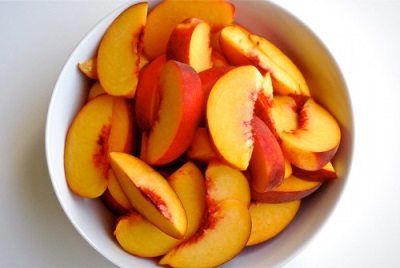From what age can nectarine be given to children?
Fruits lure like babies natural sweetness and pleasant taste, and parents - a valuable vitamin-mineral composition. In an effort to diversify the fruit menu of the karapuz, many mothers think about the introduction of nectarine in the feeding. It differs from peaches in a smooth skin and a sweeter taste. At what age can you give the crumbs such a fruit for the first time, how is it useful for babies and how to include it in the children's menu correctly?
Benefit
- Nectarines are rich in vitamins C, A, B-groups, E, K, beta-carotene, choline, potassium, copper, phosphorus, zinc, calcium, iron and many other compounds important for the development of the child's body.
- These are low-calorie fruits containing quite a lot of dietary fiber and pectin, which makes them useful for digestion.
- The use of nectarines has a positive effect on metabolic processes and the state of blood vessels.
- Nectarines have the ability to normalize the acidity of gastric juice, slow down the inflammatory process and prevent anemia.
You will learn more about the benefits and harms of nectarines in the program “Live Healthy”.
Minuses
- The high carbohydrate content makes nectarine an undesirable food for diabetes or overweight.
- Nectarines have diuretic properties, so they are not advised to eat before bedtime.
- Excessive consumption of nectarine can cause digestive upset.
From how many months can you put in feed?
Acquaintance with the nectarine of an infant baby, fed by mother's milk, is recommended at the age of 7 months, when the crumb has already tried apples and pears. Artificial babies can be treated with such fruit a month earlier.
In what form to give?
The smallest gourmet nectarines are offered in the form of mashed potatoes. To make it, take a ripe fruit, wash it well and put it in boiling water for about a minute. Next, the nectarine is cooled (can be placed in cold water or a bowl with ice), cleaned from the skin and bones, then cut into cubes, placed in a blender and crushed to obtain a homogeneous mass. For a more delicate texture, mash up with a little water.
Older children nectarines offer fresh, cut into small pieces. They can be put in child niebler.
They are often added to the curds and yogurts, as well as various pastries. In addition, from the nectarines prepare jam and jam.
Tips for choosing
For baby food, buy nectarines of bright color with a pleasant smell. Their skin should not be too pale, but very dark fruits should be discarded. Do not take nectarines with stained, wrinkled or damaged surfaces. The fruit should be elastic when pressed, and not too soft. Store fresh nectarine in a refrigerator for a maximum of 5 days.
What to do if you are allergic?
Cases of intolerance to nectarines are quite rare and are usually associated with the content of beta-carotene. If a child after the first portion of the puree of such a fruit or a few days after the start of the introduction of nectarine in the diet, redness, rash, diarrhea or other signs of allergy appeared, the new product is immediately canceled. You can try again to enter nectarines in the children's menu in a few months.































































